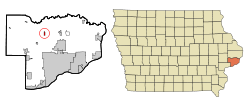Donahue, Iowa
Donahue is a city in Scott County, Iowa, United States. The population was 346 at the 2010 census. The city has a mayor-council form of government.
Donahue, Iowa | |
|---|---|
 Location of Donahue, Iowa | |
| Coordinates: 41°41′43″N 90°40′29″W | |
| Country | United States |
| State | |
| County | Scott |
| Government | |
| • Mayor | Ken Schoenthaler |
| Area | |
| • City | 0.35 sq mi (0.92 km2) |
| • Land | 0.35 sq mi (0.92 km2) |
| • Water | 0.00 sq mi (0.00 km2) |
| Elevation | 709 ft (216 m) |
| Population | |
| • City | 346 |
| • Estimate (2019)[3] | 368 |
| • Density | 1,036.62/sq mi (400.59/km2) |
| • Metro | 382,630 (135th) |
| Time zone | UTC-6 (Central (CST)) |
| • Summer (DST) | UTC-5 (CDT) |
| ZIP code | 52746 |
| Area code(s) | 563 |
| FIPS code | 19-21720 |
| GNIS feature ID | 0455950 |
| Website | www.scottcountyiowa.com/cities/donahue.php |
Education
Donahue is part of the North Scott School District, based in nearby Eldridge, and is home to one of the district's five elementary schools. Elementary-aged students attend John Glenn Elementary, while older students travel to Eldridge to attend either North Scott Junior High School or North Scott High School.
Geography
Donahue is located at 41°41′43″N 90°40′29″W (41.695179, −90.674635).[4]
According to the United States Census Bureau, the city has a total area of 0.35 square miles (0.91 km2), all land.[5]
Demographics
| Year | Pop. | ±% |
|---|---|---|
| 1910 | 64 | — |
| 1920 | 101 | +57.8% |
| 1930 | 98 | −3.0% |
| 1940 | 89 | −9.2% |
| 1950 | 105 | +18.0% |
| 1960 | 133 | +26.7% |
| 1970 | 216 | +62.4% |
| 1980 | 289 | +33.8% |
| 1990 | 316 | +9.3% |
| 2000 | 293 | −7.3% |
| 2010 | 346 | +18.1% |
| 2019 | 368 | +6.4% |
| [6] Source:"U.S. Census website". United States Census Bureau. Retrieved March 29, 2020. and Iowa Data Center Source: | ||
2010 census
As of the census[2] of 2010, there were 346 people, 124 households, and 97 families living in the city. The population density was 988.6 inhabitants per square mile (381.7/km2). There were 127 housing units at an average density of 362.9 per square mile (140.1/km2). The racial makeup of the city was 98.8% White, 0.3% African American, and 0.9% from two or more races. Hispanic or Latino of any race were 0.9% of the population.
There were 124 households of which 46.8% had children under the age of 18 living with them, 69.4% were married couples living together, 4.0% had a female householder with no husband present, 4.8% had a male householder with no wife present, and 21.8% were non-families. 16.1% of all households were made up of individuals and 4.8% had someone living alone who was 65 years of age or older. The average household size was 2.79 and the average family size was 3.14.
The median age in the city was 35.4 years. 30.9% of residents were under the age of 18; 2.6% were between the ages of 18 and 24; 32.1% were from 25 to 44; 25.8% were from 45 to 64; and 8.7% were 65 years of age or older. The gender makeup of the city was 47.1% male and 52.9% female.
2000 census
As of the census[8] of 2000, there were 293 people, 103 households, and 83 families living in the city. The population density was 870.6 people per square mile (332.7/km2). There were 105 housing units at an average density of 312.0 per square mile (119.2/km2). The racial makeup of the city was 99.66% White. Hispanic or Latino of any race were 0.34% of the population.
There were 103 households out of which 35.9% had children under the age of 18 living with them, 71.8% were married couples living together, 4.9% had a female householder with no husband present, and 19.4% were non-families. 13.6% of all households were made up of individuals and 4.9% had someone living alone who was 65 years of age or older. The average household size was 2.84 and the average family size was 3.13.
28.3% are under the age of 18, 7.2% from 18 to 24, 31.1% from 25 to 44, 24.6% from 45 to 64, and 8.9% who were 65 years of age or older. The median age was 36 years. For every 100 females, there were 109.3 males. For every 100 females age 18 and over, there were 107.9 males.
The median income for a household in the city was $56,250, and the median income for a family was $63,542. Males had a median income of $43,750 versus $21,583 for females. The per capita income for the city was $24,895. About 5.1% of families and 11.0% of the population were below the poverty line, including 23.2% of those under the age of eighteen and 7.7% of those sixty five or over.
Notable person
- Chris Brase, Iowa State Senator.
References
- "2019 U.S. Gazetteer Files". United States Census Bureau. Retrieved July 17, 2020.
- "U.S. Census website". United States Census Bureau. Retrieved May 11, 2012.
- "Population and Housing Unit Estimates". United States Census Bureau. May 24, 2020. Retrieved May 27, 2020.
- "US Gazetteer files: 2010, 2000, and 1990". United States Census Bureau. February 12, 2011. Retrieved April 23, 2011.
- "US Gazetteer files 2010". United States Census Bureau. Archived from the original on July 2, 2012. Retrieved 2012-05-11.
- "Total Population for Iowa's Incorporate Places: 1850–2010". State Library of Iowa. Retrieved March 6, 2011.
- "Census of Population and Housing". Census.gov. Retrieved June 4, 2015.
- "U.S. Census website". United States Census Bureau. Retrieved 2008-01-31.